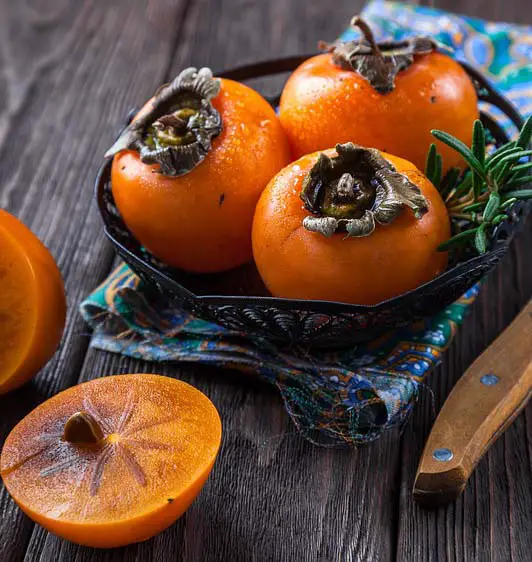
When you first look into adding a persimmon tree to your edible landscape, a common question comes up: Do you need two trees for fruit, or is one enough? I had the same question back when I planted persimmons, and it took some digging to sort through the information.
In general, native American persimmon varieties (Diospyros virginiana) need a male and a female tree for pollination. Asian or Japanese cultivars (D. kaki) either need two opposite-gendered trees for pollination, or they can be self-fruitful.
Depending on what type of persimmon you want to grow, one tree might be enough, or you may need multiples. How can you tell a persimmon tree’s gender? How far apart do the trees need to be? I’ll answer all of these questions in this article. But first, let’s back up and discuss how different kinds of persimmon trees are pollinated, and what exactly that means for you, the gardener.
How are persimmon trees pollinated?
American Persimmon Tree Pollination
American persimmon trees (D. virginiana), as the name suggests, are native to the eastern United States. These trees grow very large and bear small fruits that are extremely sweet when ripe. (How large? Read How Big Does a Persimmon Tree Grow? to find out.)
Most American persimmon varieties need both a male and female tree for pollination. Female trees are the ones that bear the fruit, and they need fertilization from the pollen of male flowers. A single persimmon tree can be male or female (known as a dioecious tree), although sometimes male flowers grow on female trees, and vice versa.
Rarely, a male tree may produce a “perfect” flower with both male and female characteristics. These flowers can produce persimmons, but they are usually atypical fruits different from what is usual for that cultivar. Persimmon trees are even known to change sex from year to year, making things even more confusing.
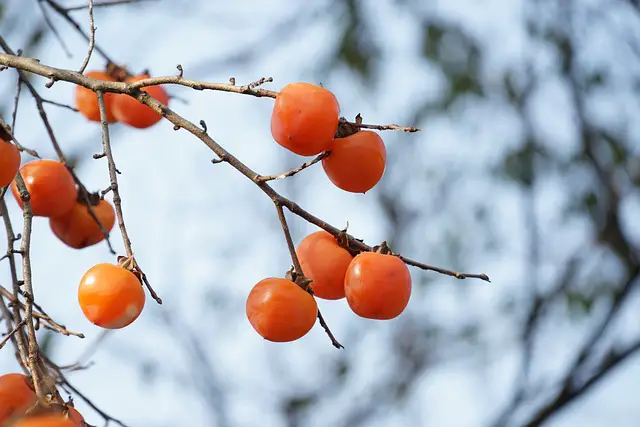
There are a few self-fruitful American persimmons, although these are by far the exception. The cultivars ‘Meader’ and ‘Prok’, for example, will produce seedless fruit without pollination from a male tree.
Self-fruitful trees (known as parthenocarpic trees) do not need pollination to produce fruit. These trees can still be pollinated by a male tree, however, and the resulting fruit will have seeds. Often, pollinated persimmons will also grow larger and have better flavor.
Asian/Japanese Persimmon Tree Pollination
Asian (or Japanese) persimmons (D. kaki) can have female, male, and/or perfect flowers all on the same tree. Many Asian varieties produce delicious fruit from a single tree, without needing a pollinizer (a source of pollen, in this case, a male persimmon tree). ‘Fuyu’, ‘Ichi-Ki-Kei-Jiro’, ‘Tamopan’, and ‘Hachiya’ are cultivars that produce good fruit without pollination.
Related: American vs. Asian Persimmons: What’s the Difference?
Some varieties don’t produce fruit as consistently without pollination, however. Unpollinated trees may drop fruit prematurely, or may just have an inferior crop. Some Asian persimmons have fruit that changes in appearance and flavor depending on whether it’s been pollinated, known as pollination-variant.
Persimmon classification: Two main ways persimmon flavors are classified are astringent (A) vs. non-astringent (NA), and pollination-constant (PC) vs. pollination-variant (PV). Persimmon cultivars are often labeled as PCNA, PCA, PVNA, or PVA, depending on their characteristics.
Pollination-variant persimmons have light-colored seedless flesh when unpollinated, and darker brown flesh with seeds when pollinated (often with a change in flavor). ‘Chocolate’ is a pollination-variant non-astringent (PVNA) persimmon, and ‘Gailey’ is a pollination-variant astringent (PVA) variety. Read this article to learn more about the differences between astringent and non-astringent persimmons.
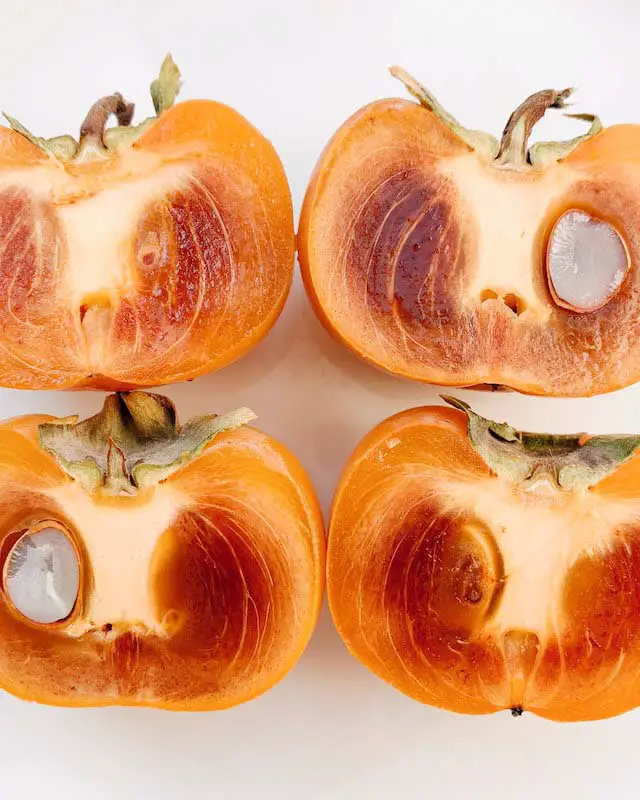
Persimmons that have the same flesh color whether pollinated or not are called pollination-constant. ‘Fuyu’ (PCNA) and ‘Hachiya’ (PCA) are two popular pollination-constant Asian persimmons. American persimmons are all pollination-constant and astringent.
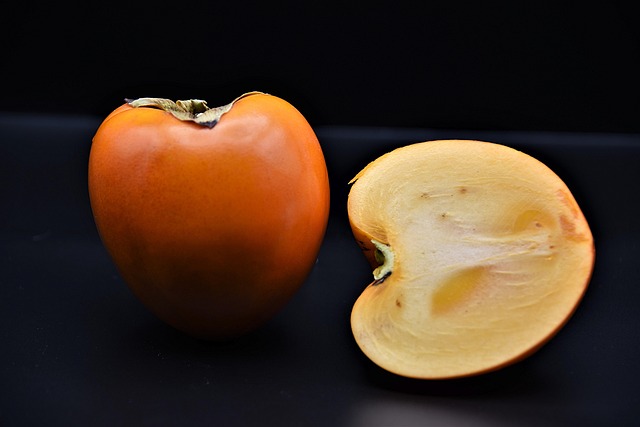
In recent years, plant breeders have begun cultivating American/Japanese hybrid persimmon varieties. These trees combine characteristics of both D. virginiana and kaki. They are compact like Asian persimmons but generally sweeter and more cold-hardy like American persimmons.
Most of these hybrids are parthenocarpic, meaning they can produce fruit without pollination but may have better harvests if pollinated. ‘Nikita’s Gift’ and ‘Mikkusu’ (or ‘JT-02’) are some of the most popular hybrid persimmon varieties.
Persimmon Pollinators
Pollinators are the agents that transfer pollen from one flower to another. For persimmons, the main pollinators are honey bees and native bees (here’s an interesting article from The National Wildlife Federation that explains the differences between these types of bees).
For some plants and trees, pollen carried by the wind is enough to pollinate flowers. But for most fruit trees, including persimmons, the pollen must be carried directly by the insect from a male flower to a female flower.
How close do persimmon trees need to be for pollination?
As a rule, plant American persimmon trees at least 30 to 50 feet apart to give them room to grow. But luckily, they can be pollinated from much farther away. In fact, if you live in the American persimmon’s native region (the eastern U.S.), you may be able to get away with planting only one female tree because there are probably native male trees in nearby forests.
Perhaps starting a bee colony in your backyard could increase your persimmon harvest. Honey bees will pollinate a persimmon tree from up to three miles away from their hive. Native bees will carry pollen over shorter distances, within about a hundred yards.
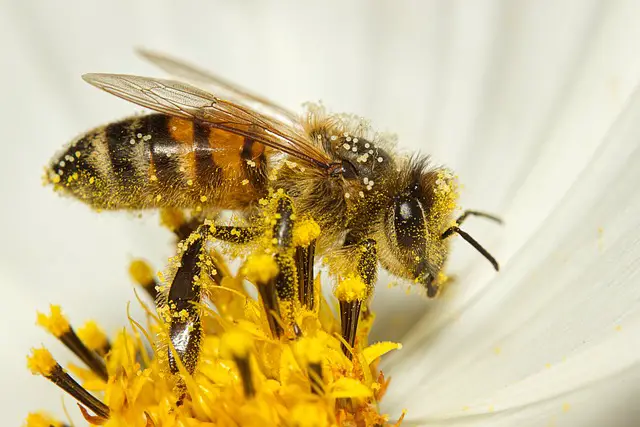
Unfortunately, it takes 5 to 10 years for an American persimmon tree to begin flowering, and only then can you tell whether the tree is male or female. You’d have to plant several persimmon tree saplings and hope that you have both sexes present.
As an alternative to just planting a bunch of trees and crossing your fingers, look for a grafted American persimmon tree available at a nursery to ensure that you are getting a female. Buying an American persimmon at a nursery is a good idea for many reasons. Named cultivars such as ‘Prok’, ‘Early Golden’, and ‘John Rick’ tend to have better flavor and more consistent quality than unnamed native trees.
The best pollinizer cultivar for American persimmons is called, simply, ‘American Male’. Commercial persimmon orchards typically plant one male tree for every eight female trees. Have a look around the neighborhood – if there is a male tree within a reasonable distance, you may not need to plant another.
Asian persimmons can be planted about 15 to 20 feet apart. Double-check your cultivar to see if it is self-fertile or if it needs a second tree. ‘Fuyu’, ‘Gailey’, and ‘Gosho’ are good pollinizers for female Asian/Japanese persimmons.
To learn how to find the best location for your persimmon tree, plus exactly how to plant it, read Planting a Persimmon Tree: Where, When, and How to Do It.
Note: Japanese and American persimmon trees don’t cross-pollinate. Each species needs its own pollinizer to produce fruit.
Identifying Male and Female Persimmon Trees
So how do you tell whether your tree is male or female? You take a look at the flowers in spring. Persimmon flowers are fairly innocuous compared with other fruit trees. They are all yellow-green, bell-shaped, and small, and they tend to hide under the large green leaves of the tree. But if you look closely, you’ll be able to spot the differences to identify the tree’s gender.
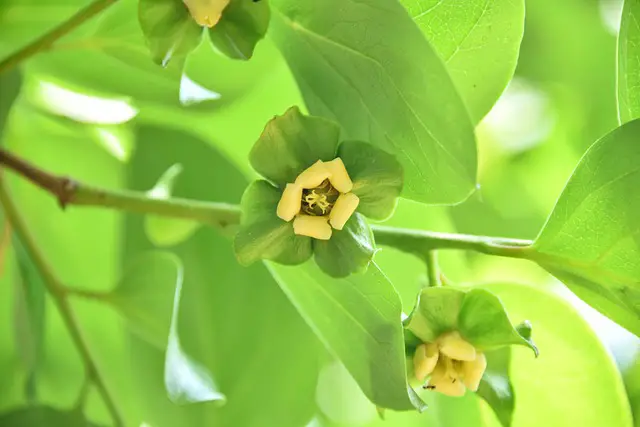
Male flowers
- Grow in clusters of three.
- Often pink-tinged in color.
- Grow on somewhat shorter stalks, about 1/4 to 1/2 inch.
- Have tiny, almost unnoticeable calyces at the base.
- Smaller than female flowers.
- Have stamens that produce pollen.
Female flowers
- Grow singly.
- Often tinted off-white or cream.
- Grow on slightly longer stalks, about 1 inch.
- Have larger, thick calyces at the base. These become the characteristic leathery-looking leaves/petals at the stem end of a persimmon.
- Have pistils and sterile stamens (without pollen).

